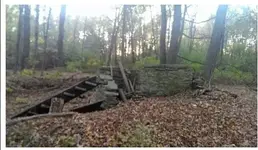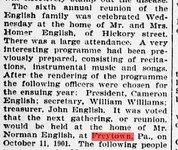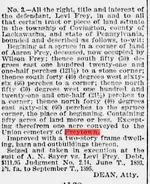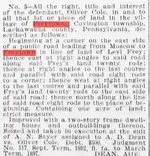Local History: Ghosts on the map - News - The Times-Tribune

Michael J. Mullen / Staff Photographer The remains of Freytown Cemetery Freytown Road, in Covington Twp.
Old-timers say that if you take a walk in the wooded area near Maple Avenue and South Abington Road, you might catch a fleeting glimpse of a shadowy figure toting a rifle.
But don't worry. Chances are, it's just a ghost defending the decaying piles of wood and crumbling stone foundations - the only signs that remain of a small settlement established more than a century ago.
Locals know it as the Forgotten Village. Though details are scarce, legend holds that a group of Russians settled there in the late 1800s. Those who have explored the woods there claim ghosts can be found among the trees.
The Forgotten Village isn't the region's only ghost town. A small village called Freytown, in what is now Covington Twp., was first settled in 1830 and, in the space of 50 years, grew to more than a dozen homes, a sawmill and brickyard, a church and cemetery. In the early 1900s, the Scranton Gas and Water Co. purchased Freytown properties to build a reservoir. Only a faint trace remains of the bustling village today.
Likewise, the once-bustling coal mining town called Edgerton, just east of Mayfield, has disappeared from the landscape. The town's residents moved away after the coal mine closed in the early 1900s, leaving behind three streets lined with company homes, a schoolhouse, two taverns and a store.
And if you know where to look, you can spot a cogged water wheel nearly hidden in the undergrowth near the Delaware River in northern Wayne County. The old wheel was part of a now-vanished logging village called Stockport.
Edgerton grew up around the imaginatively-named Devil's Eyebrow mine, developed by Simpson & Watkins, one of the largest independent operators of the anthracite industry. After a breaker was erected there in 1883, the town sprung up quickly and became one of the liveliest and most prosperous communities in the anthracite coal belt, according to a news article in December 1940.
In its heyday, about 300 people lived in company houses that lined Edgerton's three streets. The men earned 39 cents a day working in a mine called Devil's Eyebrow, descending 20 feet underground to extract coal.
When the vein was exhausted, mine operations ended. When the breaker was torn down in 1904, Edgerton was all but deserted. By 1921, few traces remained of the town.
Stockport's beginnings date back to 1790. Located off Route 191 between Equinunk and Hancock, N.Y. Its proximity to the Delaware River contributed to its growth. Grain, maple sugar and whiskey were shipped down the river on log rafts destined for Philadelphia and beyond. As more and more people moved into the community, water-powered saw mills and a grist mill sprang up.
But the rise of the railroad brought about Stockport's demise. By 1920, the town was deserted.
By 1972, all that remained of the old logging town were a small collection of dilapidated clapboard homes nearly swallowed by overgrown bushes and tall weeds. Handpainted signs warned trespassers to keep out of the small cemetery, while apples ripened on branches of trees planted a century before.














